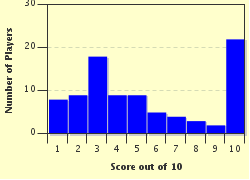Quiz Answer Key and Fun Facts
1. The Chinese are credited with the discovery of gunpowder and the invention and development of fireworks. What is believed to have been roasted to create the first firecracker?
2. Roger Bacon (1214-1294), a Franciscan Friar, is famous for his use of scientific method. Concerning fireworks and gunpowder he wrote "... if you light it you will get thunder and lightening if you know the trick". He had worked out the recipe for gunpowder. However, he was cognizant of the danger if this should be used in warfare. How did he "hide" his discovery?
3. The firework displays were increasingly popular in the England. They are mentioned by Shakespeare. Queen Elizabeth I (1533-1603) was so intrigued and enchanted by the displays that she created a new post. What post was created?
4. The folk responsible for igniting the fireworks are traditionally called "wild men", "firemasters" or which of these colorful nicknames?
5. Amédée-François Frézier published a study on fireworks in 1706 and then revised it in 1747. This study concerned the recreational and ceremonial uses of fireworks, rather than their military uses. What title was this study given when published?
6. Georg Friedrich Handel was commissioned by King George II of Great Britain to compose "Music for the Royal Fireworks" as a celebration of signing of the Treaty of Aix-la-Chappelle in 1748. Which war did this treaty end?
7. For centuries, though it was known how to propel fireworks into the air, this was mostly done for military maneuvers. The early firework display usually had little in the way of aerial effects, but relied on the ground displays that were built and then lit. Which of these wheels were often formed to rotate while the firework burned?
8. The first Philadelphia Independence day celebration for the new United States included an official dinner, 13-gun salutes, speeches, parades and fireworks. Which day was the celebration?
9. Until the 1830s, fireworks displays were only orange, gold and silver. The discovery that adding various metallic salts and a chlorinated powder to the equation meant that reds, greens, blues and yellows could be exhibited. In which country was this discovery made?
10. Disneyland opened in 1955 without fireworks, however they were presented in the 1956 season and have been a part of the entertainment since. In the late 1960s a system was developed to fire the shells electronically rather than by hand. What improvement was added in 2004?
Source: Author
mlcmlc
This quiz was reviewed by FunTrivia editor
bloomsby before going online.
Any errors found in FunTrivia content are routinely corrected through our feedback system.


